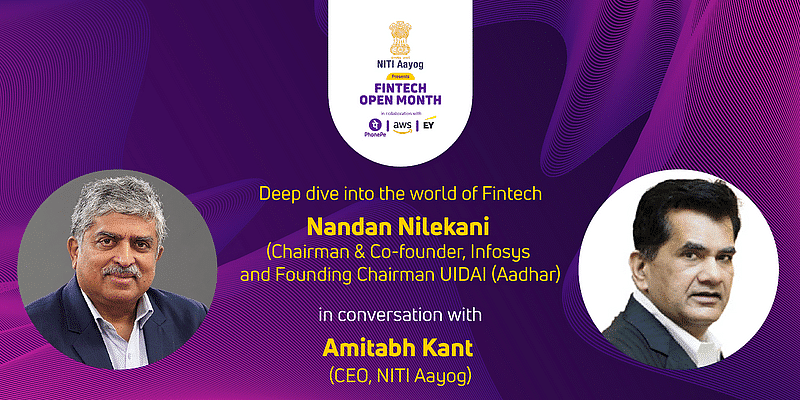Financial Ecosystems driving inclusion in India
Talking about Indian fintech, Amitabh and Nandan agreed that the first phase of the fintech revolution started with Aadhar and UPI. These were the building blocks of a tech infrastructure that helped us move away from the traditional way of doing business and take a big leap towards financial inclusion. Aadhar created a digital footprint for 1.3 billion people which made the world’s largest Direct Benefits Transfer (DBT) program possible during the pandemic – the government could directly transfer social aid to Aadhaar linked accounts, skipping any middlemen and resulting malpractices. Similarly, UPI – the platform that made one-click payments possible for any smartphone user, ushered in a new financial era for countless demographics of the Indian population.
Nandan further added that RBI’s Account Aggregator which was launched in September last year may just be the next big thing in the fintech world. This framework aims to make financial data more accessible by creating data intermediaries called Account Aggregators (AA) which collect and share a user’s financial information from a range of entities that hold consumer data called Financial Information Providers (FIPs) to a range of entities that are requesting consumer data called Financial Information Users (FIUs) after obtaining the user’s consent. This involves the collection, assembly and synthesis of information from multiple accounts – loan/credit, savings and current accounts, credit cards and investments (mutual funds, demat accounts, brokerage accounts); government accounts such as public provident fund and income tax returns data – all in one place. The data collection, collation and sharing are enabled through open application programming interface (API) connections. For instance, if a user applies for a loan, the lender (an FIU) will require access to the previous financial statements of the user – which reside with the user’s bank (an FIP) – in order to check their creditworthiness.The AA framework provides a secure and efficient way of doing so, which will help in reducing transaction costs and financial frauds while prioritizing the user’s consent. If these cost savings are passed on to the user, they can access swift banking services at a reduced cost. Nandan believes that in the next few years we are going to see a dramatic growth in Account Aggregator, which will encompass a large number of financial applications.
What the Future Holds: Digibanking, Cryptocurrency & Financial Policymaking
When Amitabh asked if India was ready for digital only banks as a complete replacement of brick and mortar institutions, Nandan opined that there is a huge role for digital only banks. The pandemic has accelerated digital adoption and India is now a country with a few hundred million smartphones. But it’s important to understand that India is a transaction-first Internet economy, as opposed to the US for instance, which was an advertising-first Internet economy. The early business models on the western Internet were advertising oriented (Google, Facebook etc.) Here, the advertising revenues are not very high and we have an economy that requires high volume, low cost and efficient transactions (such as UPI). Any infrastructure that makes this possible for the end user by reducing the cost of brick and mortar centers would be a welcome change. He added that India needs more banks and more competition among banks to drive higher financial inclusion for the consumers, and digital only banks can do this and much more.
Talking about the 2022 Budget and the Central Bank’s digital rupee, Amitabh asked what implications it could hold in the day to day lives of Indians. Nandan stated that we live in an era where blockchain has made seamless interactions possible between cryptocurrency and Fiat money or other financial assets. Platforms like Ethereum and Avalanche have their own currencies that were earlier only valuable because many people assigned value to it or because there were finite token reserves – these are now being made more usable by a class of cryptocurrencies called Stablecoins. Stablecoins are based on the premise that for every digital dollar there would be a real dollar behind it and one could use stablecoins to convert digital money into paper money. It plays a huge part in crypto currency exchanges and now the Central Bank has issued an alternative to Stablecoin in the form of the digital Rupee. He believes this would be a much more efficient digital currency than private Stablecoins which can actually be very volatile. A Stablecoin may run short on reserves, but the central government backed digital rupee is essentially a Fiat currency in digital form. It’s a 24×7 currency that can be migrated back and forth – and especially because India has built all the payment rails of UPI – it would not only be very easy to integrate this digital currency into financial transactions for millions of people, but doing so could also help in reducing costs, further aiding financial inclusion.
Amitabh follows up with questions about the inevitability of a crypto economy, India’s readiness for it and the suggestions to financial policymakers. Nandan believes that the government has been very strategic about crypto and it has made a transformative move by defining a class of digital assets that includes crypto assets and NFTs. It has mandated tax on these transactions and by doing so it has acknowledged their legitimacy. This essentially makes crypto a commodity just like gold, which can be sold and bought, and carries tax on any gains. This ensures crypto digital assets follow all the requirements of India’s laws, whether it’s prevention for money laundering act, kyc requirements, sending money abroad etc. With this and the promotion of the digital rupee, India is on its way to designing a very sensible policy regime.
He further adds that this budget move which has legitimized digital assets and their taxation will encourage more people to participate in the crypto economy. India could soon become a big base for crypto with companies like Polygon which has its own blockchain and recently raised $450 million, and exchanges like Coinswitch Kuber, cropping up. Nandan believes that young Indians will play a big role in building out the digital infrastructure of the blockchain world and make interesting leaps in the area of decentralized finance – where you can create financial chains without any central authority. Decentralized finance with proper guardrails could be a very powerful thing and usher in greater financial inclusion.
The Global Potential of Young Indian Entrepreneurs
Speaking of Indian talent, Amitabh asks Nandan the message he would like to share with young Indian entrepreneurs – about growth opportunities and pitfalls to avoid. The latter believes that India is unique in its ability to create public digital goods which provide rails for financial Inclusion. For example, Aadhaar and Aadhaar kyc, PAN based kyc, Video kyc etc. are digital methods that seamlessly enable opening a bank account or buying mutual funds. UPI is another digital method solving for payments, and it’s a free rail supporting very high volume transactions. It’s not feasible for us to build a singular payment app unlike some other countries, where one or two platforms become very powerful with unfavorable consequences. A key requirement for Indian entrepreneurs is to understand that many other things that don’t exist in other parts of the world exist here and they are better off not trying to reinvent that wheel because they’ll hit against a very large population scale. At the same time, the opportunity is immense because India’s financialization has just begun. India is a country where assets were historically kept in real estate and gold. For the first time we are seeing a massive financialization of assets. People are moving their assets into mutual funds, stocks, bonds, crypto etc. and and there’s going to be new wealth creation that will come into the financial markets, and the existing stock of non financial assets will also flow into the markets – but the current penetration of these products is very low on the top. In his view, any entrepreneur who financializes this and takes it to millions of people will do extremely well.
Another area where India’s young entrepreneurs are rewriting the book is small business, and a lot of great companies now provide tools for small enterprise owners. These businesses are being brought into the digital world as they have to file their GST, income tax etc. online and they take payments online – they need user friendly, intuitive products to help them navigate this. According to Nandan, as Indian companies become unicorns or decacorns, they will become global players propelled by the experience they have got in India of providing very high volume, very low cost, highly scalable financial infrastructure for a billion people.
ONDC: Powering inclusion and change for Indian e-commerce
Being an integral part of the Open Network for Digital Commerce (ONDC), Nandan had some vital insights on how this upcoming platform could transform Indian e-commerce and bring about unprecedented growth for MSMEs. ONDC is a network based on open protocol and will enable local commerce across segments, such as mobility, grocery, food order and delivery, hotel booking and travel etc, to be discovered and engaged by any network-enabled application. The platform aims to create new opportunities, curb digital monopolies, and support small traders and help them get online. India is going to be a trillion dollar retail industry with about 20% e-commerce – that means there will be $200 billion of e-commerce every year in India. It’s important for every supplier in the country, every manufacturer, everyone who owns a brand – to be able to sell easily through online channels. It’s also imperative that small retailers participate in the e-commerce revolution. Essentially, ONDC creates a set of interoperable protocols and allows retailers, suppliers, dedicated logistics companies and consumers to plug into many platforms. If one wants to buy something, they can just put out a request and a retailer can provide the details of the commodity hassle-free. Similarly, brands can find customers and get discovered on this platform – so it makes e-commerce much more inclusive. There’s a tremendous amount of energy behind ONDC as the technocrats, the government and businesses agree that it’s the way forward.
Demystifying Diversity and Inclusion for Women Entrepreneurs
Nandan and Amitabh agreed that having more women entrepreneurs is very critical for the Indian financial ecosystem. Nandan believes that we have created an onboarding ramp for women entrepreneurs, in many ways it has never been easier to become an entrepreneur. The tools of the game are in place – one can start a company online, pay taxes online and run a business smoothly. What women entrepreneurs need at this hour is creation of wealth networks and groups of investors who want to support their business – because capital is a factor and as per Nandan, too much of it is an ‘old boys club’ currently. It is important to open up the capital to women and match young women entrepreneurs with potential pools of wealth.
Watch the full video of the conversation: https://www.youtube.com/watch?v=7GZkdI_4FJg










